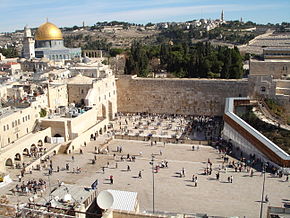West Wall
 |
|
| Alternate name | Wailing Wall Kotel Al-Buraq Wall |
|---|---|
| Location | Jerusalem |
| Coordinates | 31°46′36″N 35°14′04″E / 31.7767°N 35.2345°ECoordinates: 31°46′36″N 35°14′04″E / 31.7767°N 35.2345°E |
| Length | 488 metres (1,601 ft) |
| Height | exposed: 19 metres (62 ft) |
| History | |
| Builder | Herod the Great |
| Material | Limestone |
| Founded | 19 BCE |
| Site notes | |
| Condition | preserved |
The Western Wall, Wailing Wall or Kotel (Hebrew: ![]() הַכֹּתֶל הַמַּעֲרָבִי , translit.: HaKotel HaMa'aravi; Ashkenazic pronunciation: HaKosel HaMa'arovi; Arabic: حائط البراق, translit.: Ḥā'iṭ al-Burāq, translat.: the Buraq Wall, or Arabic: المبكى al-Mabkā: the Place of Weeping) is an ancient limestone wall in the Old City of Jerusalem. It is a relatively small segment of a far longer ancient retaining wall, known also in its entirety as the "Western Wall". The wall was originally erected as part of the expansion of the Second Jewish Temple by Herod the Great, which resulted in the encasement of the natural, steep hill known to Jews and Christians as the Temple Mount, in a large rectangular structure topped by a huge flat platform, thus creating more space for the Temple itself and its auxiliary buildings.
הַכֹּתֶל הַמַּעֲרָבִי , translit.: HaKotel HaMa'aravi; Ashkenazic pronunciation: HaKosel HaMa'arovi; Arabic: حائط البراق, translit.: Ḥā'iṭ al-Burāq, translat.: the Buraq Wall, or Arabic: المبكى al-Mabkā: the Place of Weeping) is an ancient limestone wall in the Old City of Jerusalem. It is a relatively small segment of a far longer ancient retaining wall, known also in its entirety as the "Western Wall". The wall was originally erected as part of the expansion of the Second Jewish Temple by Herod the Great, which resulted in the encasement of the natural, steep hill known to Jews and Christians as the Temple Mount, in a large rectangular structure topped by a huge flat platform, thus creating more space for the Temple itself and its auxiliary buildings.
...
Wikipedia

